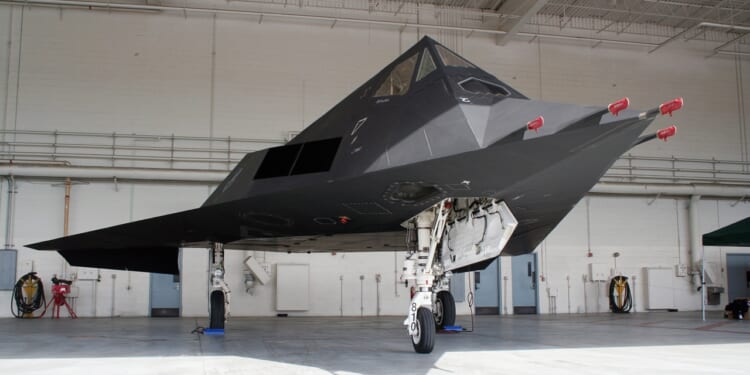The F-117s are no longer as cutting-edge as they once were, but they can still be effective in a pinch. And America is in quite a pinch today.
The F-117A Nighthawk is one of America’s most iconic warplanes in history. Officially retired in 2008, the sleek, triangular, all-black stealth bomber has made a handful of flights out of the Tonopah Test Range in Nevada over the years. More recently, The Aviationist has published photos of two F-117A Nighthawks engaging in midair refueling in the skies above California.
As of 2025, there are around 45 F-117A Nighthawk airframes in the Air Force’s inventory, with the Air Force disposing of around two to three per year—some of which are being transferred to museums.
Yet the service has no plans for full retirement soon. Indeed, the Air Force signed a 10-year maintenance and logistics contract in 2024, keeping the stealth jets operational at least through 2034.
The F-117A Nighthawk’s Specifications
- Year Introduced: 1983
- Number Built: 64 production aircraft + 5 prototypes
- Length: 65 ft 11 in (20.09 m)
- Wingspan: 43 ft 4 in (13.20 m)
- Weight: ~29,500 lb (13,380 kg) empty; ~52,500 lb (23,810 kg) MTOW
- Engines: Two General Electric F404-F1D2 non-afterburning turbofans (~10,600 lbf thrust each)
- Top Speed: ~684 mph (1,100 km/h; Mach 0.92 at altitude)
- Range: ~930 nmi (1,720 km; 1,070 mi) combat radius
- Service Ceiling: ~45,000 ft (13,700 m)
- Loadout: Two internal bays for up to 5,000 lb of precision-guided bombs (e.g., GBU-10, GBU-27, or JDAM)
- Aircrew: 1
The F-117A Nighthawk’s Current Mission Is Shrouded in Secrecy
Since its retirement from combat in 2008, the F-117A has been used in adversary training—so called “red team” exercises—wherein the aircraft simulates advanced enemy stealth threats. This bird acts as an opponent to train pilots and air defense units against stealthy adversaries, helping refine tactics for detecting and countering low-signature aircraft. One of the more interesting training mission sets the plane has been given over the years has been to mimic stealthy cruise missiles in integrated air and defense drills, allowing crews to practice interception and detection against hard-to-spot profiles.
What’s more, the F-117 continues serving the United States Armed Forces by acting as a research, development, and evaluation (RDT&E) testbed. In essence, the plane is used to evaluate new technologies, including “mirror-like” finishes to reduce infrared signatures for coatings, radar systems, infrared search and track (IRST) sensors, and potential autonomous or semi-autonomous operations. This supports next-generation programs and helps assess countermeasures against evolving threats.
Because the Air Force has not fully retired this bird, a small cadre of pilots continue being trained to pilot and maintain this plane without taxing frontline assets.
Even though the US military is well-known for its wastefulness, what the Air Force has done with the F-117A Nighthawk is actually quite cost-effective. By leveraging the Nighthawk’s proven stealth without the need for new production, the Pentagon is maintaining a critical capability, furthering their own training, all without opening up entirely new—costly—production lines.
The Air Force Seems to Be Upgrading Its F-117s. Why?
As for the recent sightings of the Nighthawk engaged in midair refueling in the skies of California, this is not the first in recent years that the Nighthawk has been seen in daylight. Indeed, sightings of this once ultra-secretive plane have become more frequent since 2021. While there are no combat deployments since these planes were retired in 2008, Washington faces increasing threats around the world—and is keen on expanding its capabilities without breaking the bank. Sure, the F-117s are no longer as cutting-edge as they once were—but they can still be effective in a pinch. And America is in quite a pinch today.
So not only should the US military intensify its use of the F-117, but the military must restore these birds to their proper fighting form, make whatever upgrades that are needed immediately, and get them ready for frontline action. Time is not on the Air Force’s side. It cannot wait for America’s glacial defense industrial base to produce enough B-21 Raider bombers in any meaningful timeline.
The specific incident detailed in the The Aviationist piece, as per that publication, appeared to be part of a certification for the F-117. The Air Force is ensuring that the F-117 can refuel itself with the new KC-46 Pegasus refueling tanker, which is replacing the older KC-135s and KC-10s. Making these nominally-retired Nighthawks compatible with the new KC-46 means that the F-117s can engage in longer-duration missions in remote areas. If the aircraft were truly on its way out, why would the Air Force go to such trouble?
The Nighthawk Could Be Useful in the Indo-Pacific—or at Home
Further speculation has mounted as to why the F-117s were seen in Southern California, so near to the US-Mexican border. Rumors have run rampant that the Trump administration is gearing the planes up to conduct some type of cross-border bombing missions against cartel targets in Mexico—or possibly even participate in bombing missions that sources indicate the president is readying to authorize against Venezuela.
Such missions for the “retired” F-117 would be demonstrations of these birds’ capabilities and continued relevance, contrary to what was said in 2007, when Congress authorized their retirement. Officially, however, no details have been given by the Pentagon that confirm anything more than simple routine testing and training.
But keep an eye on this story. We may be about to see the F-117A Nighthawk’s great comeback.
About the Author: Brandon J. Weichert
Brandon J. Weichert is a senior national security editor at The National Interest. Recently, Weichert became the host of The National Security Hour on America Outloud News and iHeartRadio, where he discusses national security policy every Wednesday at 8pm Eastern. He is also a contributor at Popular Mechanics and has consulted regularly with various government institutions and private organizations on geopolitical issues. Weichert’s writings have appeared in multiple publications, including The Washington Times, National Review, The American Spectator, MSN, The Asia Times, and others. His books include Winning Space: How America Remains a Superpower, Biohacked: China’s Race to Control Life, and The Shadow War: Iran’s Quest for Supremacy. His newest book, A Disaster of Our Own Making: How the West Lost Ukraine is available for purchase wherever books are sold. He can be followed via Twitter @WeTheBrandon.
Image: Shutterstock / VanderWolf Images.

















